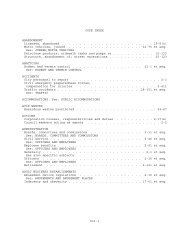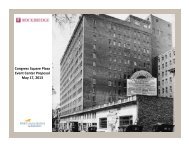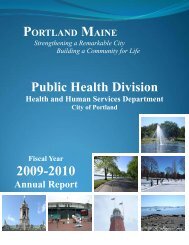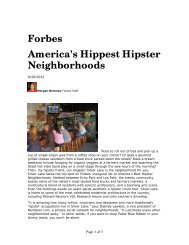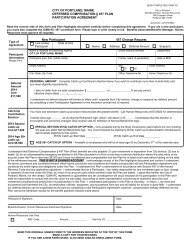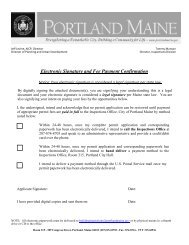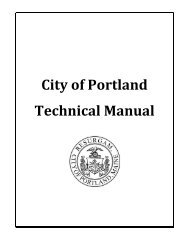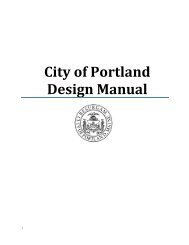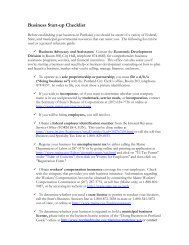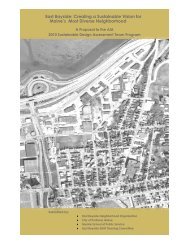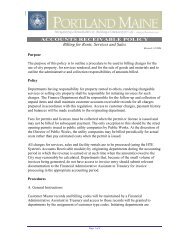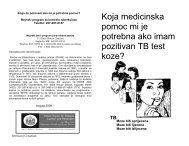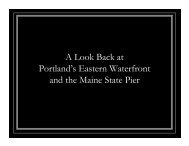Risk Management Manual - City of Portland
Risk Management Manual - City of Portland
Risk Management Manual - City of Portland
You also want an ePaper? Increase the reach of your titles
YUMPU automatically turns print PDFs into web optimized ePapers that Google loves.
<strong>City</strong> <strong>of</strong> <strong>Portland</strong><br />
<strong>Risk</strong> <strong>Management</strong> <strong>Manual</strong><br />
(Revised: 07/12/04)
RISK MANAGEMENT MANUAL<br />
TABLE OF CONTENTS<br />
SECTION I…. THE RISK DIVISION PAGE 3<br />
Purpose …………………………………………………………………. Page 3<br />
Philosophy ………………………………………………………………. Page 3<br />
Mission statement........................................................................................ Page 3<br />
<strong>Risk</strong> Division Staffing................................................................................. Page 4<br />
SECTION II…. SAFETY & ACCIDENT PREVENTION (AR 41) PAGE 5<br />
Safety and the Employee ………………………………………………… Page 5<br />
Supervisors ………………………………………………………………. Page 5<br />
Safety Committees ………………………………………………………. Page 5<br />
Regulative bodies ………………………………………………………... Page 5<br />
Technical Services ………………………………………………………. Page 5<br />
Accident Review........................................................................................ Page 6<br />
OSHA, Surveys & Loss Control................................................................. Page 6<br />
Emergency Action Plans............................................................................. Page 7<br />
SECTION III…. WORK RELATED INJURIES & REPORTING (AR 18) PAGE 8<br />
Reporting Work Related Injuries................................................................ Page 8<br />
Initial Treatment <strong>of</strong> Work Related Injuries................................................. Page 9<br />
Provider List for Work Related Injuries ………………………………… Page 10<br />
Reoccurrence and Follow- up Care ........................................................… Page 11<br />
Lost Time Injuries & Payments …………………………………………. Page 11<br />
Return to Work / Light Duty / Transitional Duty ……………………….. Page 12<br />
Coming and Going Rule; WC…………………………………………………. Page 12<br />
SECTION IV…. DRUG AND ALCOHOL USE AND TESTING (AR 19, 25, 32) PAGE 13<br />
Drug and Alcohol Testing............................................................................. Page 13<br />
Drug and Alcohol Use …………………………………………………….. Page 13<br />
SECTION V…. LIABILITY REPORTING AND INVESTIGATIONS (AR19) PAGE 14<br />
Reporting <strong>of</strong> Liability Incidents and Claims............................................... Page 14<br />
Accidents Involving <strong>City</strong> Vehicles or Personal Vehicles for <strong>City</strong> Use …. Page 15<br />
Subrogation (recovery <strong>of</strong> city losses) …………………………………… Page 16<br />
Use <strong>of</strong> Vehicles (personal and city)………………………………………. Page 16<br />
Use <strong>of</strong> Equipment and Tools…………………………………………….. Page 17<br />
Coming and Going Rule; Liability ……………………………….……. Page 17<br />
RISK MANAGEMENT MANUAL<br />
TABLE OF CONTENTS<br />
Revised 07/12/04 1
SECTION VI…. IDENTIFICATION OF RISK EXPOSURES PAGE 18<br />
Property <strong>Risk</strong>s …………………………………………………................. Page 18<br />
Outside Contractors………………………………………………………. Page 18<br />
Certificates <strong>of</strong> Insurance & Hold Harmless Agreements............................ Page 19<br />
Leases ……………………………………………………………..……. Page 19<br />
New Construction ……………………………………………………….. Page 19<br />
New Operations (including acquisition <strong>of</strong> property) ……………………. Page 19<br />
Developing Personnel Matters …………………………………………… Page 19<br />
SECTION VII…. RETENTION, ELIMINATION, TRANSFER & INSURANCE PAGE 20<br />
<strong>Risk</strong> Retention, Elimination, Transfer and Insurance.................................. Page 20<br />
Benchmark & Feedback Reports …………………………………………. Page 20<br />
SECTION VIII…. BUDGETING & LOSS FUNDING PAGE 21<br />
Worker’s Compensation …………............................................................. Page 21<br />
Liability (property & casualty)................................................................... Page 21<br />
Summary ………………………………………………………………… Page 21<br />
SECTION IX….ATTACHMENTS & LISTS PAGE 22<br />
<strong>City</strong> <strong>of</strong> <strong>Portland</strong> Incident Report<br />
List <strong>of</strong> Administrative Regulations<br />
AR 18 Work Related Injury <strong>Management</strong><br />
AR 19 Use <strong>of</strong> Vehicles<br />
AR 20 Reporting <strong>of</strong> Accidents involving <strong>City</strong> Vehicles or Personal Vehicles used for <strong>City</strong> Business<br />
or Other Potential Claims<br />
AR 25 Disciplinary Procedures<br />
AR 32 Employee Assistance Program<br />
AR 41 Safety and Accident Prevention<br />
Revised 07/12/04 2
THE RISK DIVISION, SECTION I<br />
Purpose<br />
The <strong>Risk</strong> Division<br />
This manual is an overview <strong>of</strong> the various programs, procedures and operations managed by, the<br />
<strong>Risk</strong> Division <strong>of</strong> the Human Resources Department. It is intended to be used as a resource by all<br />
department heads, managers, supervisors, employees and unions.<br />
Every department and division in the <strong>City</strong> encounters numerous risk exposures and potential<br />
losses. This manual is designed to assist you in recognizing those risks and determining what<br />
action to take to avoid them, and minimizing those losses which may be unavoidable.<br />
<strong>Risk</strong> <strong>Management</strong> Philosophy<br />
The <strong>City</strong> <strong>of</strong> <strong>Portland</strong> believes that protection <strong>of</strong> the <strong>City</strong>’s assets, both human and physical, must<br />
be a top priority. All levels <strong>of</strong> management must take responsibility for the protection and<br />
preservation <strong>of</strong> our assets through continuous attention to safe and healthy working conditions;<br />
early identification <strong>of</strong> potential sources <strong>of</strong> loss to our employees, property, residents and the<br />
public at large. We strive to develop loss control practices and procedures to address these<br />
exposures.<br />
Following the example and encouragement <strong>of</strong> management, employees are expected to follow<br />
safe work practices and actively participate in the identification <strong>of</strong> risk exposures. Employees<br />
should be an integral part in the development <strong>of</strong> work practices, policies and programs drafted to<br />
deal with the various risks affecting their workplace.<br />
Mission Statement<br />
The <strong>Risk</strong> Division is committed to providing a variety <strong>of</strong> risk reduction and prevention<br />
programs and services, both proactive and reactive. We strive to balance these efforts to<br />
promote a safe, healthy and productive workplace for our employees, minimize risk<br />
exposures to the citizens and guests <strong>of</strong> the <strong>City</strong>, and to insure that all city assets are<br />
protected or insulated against potential loss.<br />
The Safety, Loss Control and Insurance programs and services provided by the <strong>Risk</strong> Division are<br />
all designed to assist <strong>City</strong> departments in the management <strong>of</strong> the various risks. This manual<br />
presents a brief overview <strong>of</strong> the programs and services outlined in the table <strong>of</strong> contents, their<br />
purpose, and how to access and use them:<br />
Revised 07/12/04 3
THE RISK DIVISION, SECTION I<br />
<strong>Risk</strong> Division Staffing<br />
The staff <strong>of</strong> the <strong>Risk</strong> Division is available to serve as a resource to assist <strong>City</strong> departments in<br />
their safety and loss control efforts. They are also the key contacts with outside agencies that<br />
deal with safety, health and loss control issues (see table <strong>of</strong> organization):<br />
• Cressey A. Mollison, WC & Safety Program Manager........... Work 874-8622<br />
Home 839-6670<br />
Cell 653-3725<br />
• Cheryl L. Main, Liability Program Manager.......................... Work. 874-8431<br />
Home 854-8637<br />
Cell 232-0898<br />
• Jonathan Anderson, Safety & Training Officer……….……… Work 874-8608<br />
Home 353-5710<br />
Cell 233-7417<br />
• Neil Jordan, Safety & Training Officer…………………….…. Work 756-8262<br />
Home 828-4421<br />
Cell 653-2261<br />
• Christopher Winters, Executive Assistant……………………….….. 874-8635<br />
• Kathy Vosmus, <strong>Risk</strong> Administrative Assistant……………………….. 874-8624<br />
• Fax Number, <strong>Risk</strong> Division, Room 115, <strong>City</strong> Hall.............................. 874-8937<br />
• Maine Municipal Assoc., Ann Willette, Lost-Time Claims………… 1-800-590-5583<br />
• Maine Municipal Assoc., Gail Trask, Medical-Only Claims………… 1-800-590-5583<br />
• Fax Number, MMA ………………………………………………….. 626-0513<br />
• MMA 24 Hr. Emergency Answering Service….……………………. 626-3741<br />
Revised 07/12/04 4
SAFETY & ACCIDENT PREVENTION, SECTION II<br />
Safety & Accident Prevention<br />
This section is supported by AR 41<br />
Safety and the Employee: Technical safety and work procedures are established by each<br />
department and necessary instruction will be provided. Employees who have questions about any<br />
aspect <strong>of</strong> their job are encouraged to ask before proceeding. If employees have concerns about<br />
safety or health conditions in their department and are unable to resolve them with their supervisor<br />
they may use the Safety Committee and/or contact the appropriate departmental Safety & Training<br />
Officer, or the WC & Safety Program Manager, Phone: 874-8622.<br />
Supervisors: Managers, supervisors and foremen have direct responsibility to control and direct<br />
operations with the safety and health <strong>of</strong> all employees in mind.<br />
Safety Committees: Organized in the major departments, both as part <strong>of</strong> Administrative<br />
Regulation (AR41), and as part <strong>of</strong> the bargaining agreements. The joint labor-management<br />
committees are coordinated by either the WC & Safety Program Manager or the appropriate Safety<br />
and Training Officer to actively identify and evaluate potential safety and health problems posed to<br />
employees.<br />
Regulative Bodies: Occupational Safety & Health Administration (O.S.H.A.) regulations are<br />
administered by the State <strong>of</strong> Maine Bureau <strong>of</strong> Labor Standards. The <strong>City</strong> <strong>of</strong> <strong>Portland</strong> must meet<br />
these requirements as a public sector employer. These rules, as well as accepted safe work practices<br />
for the various occupations, are a foundation for carrying out the <strong>City</strong>'s mission in a safe manner.<br />
O.S.H.A. regulations require diligent effort on the part <strong>of</strong> the <strong>City</strong>’s management team and on the<br />
part <strong>of</strong> employees, including the responsibility to observe and follow all safety procedures, use<br />
protective equipment and report hazards.<br />
Technical Services: The <strong>Risk</strong> <strong>Management</strong> Division, in coordination with the appropriate Safety<br />
and Training Officer, provides the following services:<br />
• Investigates employee and supervisor inquiries, concerns and complaints regarding safety and<br />
health issues and works with management to resolve any safety or health problems;<br />
• Conducts worksite visits and safety inspections <strong>of</strong> <strong>City</strong> property to evaluate safety and health<br />
aspects <strong>of</strong> facility operations, and provides recommendations for control <strong>of</strong> hazards;<br />
• Acts as a resource in the design and delivery <strong>of</strong> training to help employees work safely and assist<br />
employees and their supervisors in carrying out their safety responsibilities;<br />
• Consults with the departments on technical safety, health, industrial hygiene and loss prevention<br />
topics.<br />
• Reports to <strong>City</strong> administration regarding loss prevention and risk management issues.<br />
Revised 07/12/04 5
SAFETY AND ACCIDENT PREVENTION, SECTION II<br />
• Evaluates Workers' Compensation claims and injury reports, vehicle accidents and other<br />
incidents, and recommends measures to prevent similar injuries or losses;<br />
Accident Review<br />
Various <strong>City</strong> departments have established an accident review procedure to allow for<br />
investigation and review <strong>of</strong> safety and prevention issues surrounding accidents involving <strong>City</strong><br />
property. Accidents are investigated by the Safety & Training Officers or their designee with the<br />
results <strong>of</strong> the investigation being forwarded to the Accident Review Committee. The Accident<br />
Review Committees are comprised <strong>of</strong> <strong>Management</strong> and Union representatives.<br />
The committees are chaired by the Safety & Training Officer with oversight responsibility<br />
assigned to the <strong>Risk</strong> Division. The committee is charged with reviewing all accidents including<br />
written testimony <strong>of</strong> employees and witnesses. The committee then issues written findings based<br />
on the investigation and testimony and establishes whether an accident was preventable or nonpreventable.<br />
The committee then will forward its findings to the appropriate Department Head<br />
outlining the reasons for its findings and any appropriate recommendations for the prevention <strong>of</strong><br />
future similar accidents. These findings may also be forwarded to the appropriate Safety<br />
Committee for review.<br />
The Accident Review Committee does not make any recommendations regarding disciplinary<br />
action resulting from its findings. It is the responsibility <strong>of</strong> the appropriate department personnel<br />
to determine what, if any, disciplinary action will be taken.<br />
OSHA, Surveys & Loss Control<br />
There are a number <strong>of</strong> different types <strong>of</strong> inspections which the <strong>Risk</strong> Division coordinates.<br />
(Note: Any time a department is requested by any party, other than a <strong>City</strong> employee, to<br />
submit to an inspection, the <strong>Risk</strong> Division shall be notified immediately. The WC & Safety<br />
Program Manager or Safety & Training Officer will be dispatched to accompany the<br />
inspector. Also notify the <strong>Risk</strong> Division if any party appears to make inspections <strong>of</strong> <strong>City</strong><br />
facilities without authorization). Types <strong>of</strong> inspections will include:<br />
• OSHA Inspections: The Maine Department <strong>of</strong> Labor (DOL), Bureau <strong>of</strong> Labor Standards,<br />
Safety Division administers OSHA regulations for public sector agencies. If an OSHA<br />
inspection should occur, a written report will be submitted by DOL to the <strong>City</strong> Manager. A<br />
copy will be forwarded to the department(s) involved and will identify any recommendations<br />
the inspector made for improved work-place safety; as well as any citations against the <strong>City</strong><br />
for failure to comply with OSHA rules and regulations; the amount <strong>of</strong> fines assessed. The<br />
<strong>Risk</strong> Division responds to all OSHA/DOL recommendations on the Cities behalf, including<br />
filing appeals to citations when appropriate.<br />
• Safety and Prevention Surveys: As noted earlier under the section on Safety and Accident<br />
Prevention, the <strong>Risk</strong> Division and the Safety & Training Officers will conduct in-house<br />
surveys, inspections and worksite visits to evaluate safety and health aspects <strong>of</strong> our facilities<br />
and operations. The full cooperation <strong>of</strong> department is needed and expected. The <strong>City</strong>’s<br />
safety staff has an extensive background with OSHA compliance and loss prevention<br />
Revised 07/12/04 6
SAFETY & ACCIDENT PREVENTION, SECTION II<br />
techniques and is ready to assist departments in meeting their safety and prevention<br />
responsibilities. <strong>Management</strong>’s active participation in this process in critical if the <strong>City</strong> is to<br />
maintain a safe, healthy and productive workplace.<br />
• Property & Loss Control (Insurance) Inspections: Maine Municipal Association’s Loss<br />
Control Division inspects select <strong>City</strong> property on a rotating basis. These Inspections take<br />
place periodically and are accompanied by the WC & Safety Program Manager. We also<br />
recommend that an appropriate department representative participate in the process. The<br />
purpose <strong>of</strong> these inspections is to assist the <strong>City</strong> with our loss control efforts and for MMA to<br />
report to their insurance underwriters regarding insured properties. Following a property<br />
insurance inspection, MMA will forward to the <strong>Risk</strong> Division an Action Plan listing loss<br />
control recommendations. The <strong>Risk</strong> Division will contact the appropriate department head<br />
responsible for responding to the action plan and it is the department head’s responsibility to<br />
comply with the recommendations in these actions plans in a timely manner.<br />
Emergency Action Plans<br />
The <strong>City</strong> must establish Emergency Action Plans to be activated in the event <strong>of</strong> an emergency<br />
that may threaten <strong>City</strong> buildings and workplaces. The Plan must be in writing for buildings<br />
where more than 10 employees are housed, and must be communicated orally in buildings that<br />
house less than 10 employees.<br />
All <strong>City</strong> employees must be familiar with the Emergency Action Plan for their<br />
building/workplace. In the event any Emergency Action Plan is activated and evacuation <strong>of</strong> a<br />
building is initiated, all employees must leave the building.<br />
Remember!<br />
• Employees may not re-enter an evacuated building under any circumstances until<br />
authorized by the Fire Department, Police Department or other authority to do so.<br />
• No alarm is a false alarm until the Fire Department makes the determination.<br />
Revised 07/12/04 7
WORK RELATED INJURIES & REPORTING, SECTION III<br />
Work Related Injuries & Reporting<br />
This section is supported by AR 18<br />
We are hopeful that with an aggressive and continuously improving safety and incident<br />
prevention program, work-related injuries will become a thing <strong>of</strong> the past. When work-related<br />
injuries do occur, it is extremely important that they be reported promptly, and that all losses<br />
related to a claim be clearly documented. All injuries resulting in bodily injury to <strong>City</strong> personnel,<br />
including volunteer and workfare personnel, need to be reported, no mater how minor.<br />
The <strong>City</strong> is self-insured for Workers Compensation. Prompt reporting <strong>of</strong> claims and potential<br />
losses is critical to minimize lost time and recovery time for the employee, and to allow for a<br />
thorough investigation into the cause <strong>of</strong> the accident.<br />
All <strong>City</strong> departments have a Liaison to the <strong>Risk</strong> Division who is responsible for processing Work<br />
Related Injury Reports.<br />
The <strong>City</strong> has retained a Third Party Administrator (TPA) to process and manage all work-related<br />
injury claims. Our TPA is Maine Municipal Association (MMA). The TPA administers<br />
Workers Compensation claims in accordance with the State <strong>of</strong> Maine Workers’ Compensation<br />
Act (M.R.S.A. Title 39).<br />
Following is a brief synopsis to be followed when reporting a work-related injury.<br />
Reporting Work-Related Injuries<br />
Any employee sustaining an injury/illness or occupational disease, or an aggravation <strong>of</strong> an old<br />
injury or illness “out <strong>of</strong> and in the course <strong>of</strong> employment” must report the injury immediately<br />
to their supervisor and departmental WC Liaison, who will assist the employee in filling out the<br />
Employee Injury Report Form. The report must be made promptly the next business day, or<br />
within 24hrs. Employees will be referred to one <strong>of</strong> the Occupational Health Care Providers<br />
participating with the city in their WC program.<br />
Employees must complete:<br />
• Employee Injury Report Form<br />
• Extra Hazardous Duty Form (fire department only)<br />
The Departmental WC Liaison must complete:<br />
• Employer Supplemental Injury Report Form.<br />
All completed forms and any other related information must be forwarded immediately to the<br />
<strong>Risk</strong> Division, Human Resources Department to arrive ASAP and no later than 2 days after the<br />
notice <strong>of</strong> injury to a supervisor or manager.<br />
Revised 07/12/04 8
WORK RELATED INJURIES & REPORTING, SECTION III<br />
When lost time is involved, forms must be faxed immediately on the date reported to the<br />
<strong>Risk</strong> Division at 874-8937.<br />
IT IS IMPERATIVE THAT THE SUPERVISOR OR WC LIAISON NOTIFY MAINE<br />
MUNICIPAL ASSOCIATION AND THE RISK DIVISION IMMEDIATELY BY E-<br />
MAIL, FAX OR PHONE WHEN AN EMPLOYEE IS GOING TO LOSE TIME AS A<br />
RESULT OF A WORK-RELATED INJURY.<br />
THE WORKERS’ COMPENSATION BOARD WILL IMPOSE A FINE OF $100 ON<br />
EMPLOYERS WHO FAIL TO REPORT A LOST TIME CLAIM WITHIN 7 DAYS OF<br />
BEING NOTIFIED BY THE EMPLOYEE. ANY FINES ASSESSED TO THE CITY<br />
WILL BE CHARGED BACK TO THE DEPARTMENT RESPONSIBLE FOR THE<br />
LATE FILING. THESE INJURIES SHOULD BE INVESTIGATED IMMEDIATELY.<br />
ALSO, MMA AND THE RISK DIVISION MUST BE NOTIFIED IMMEDIATELY<br />
WHEN THE EMPLOYEE RETURNS TO WORK. FAILURE TO DO THIS MAY<br />
RESULT IN AN UNDERPAYMENT OR OVERPAYMENT OF WORKERS’<br />
COMPENSATION BENEFITS.<br />
Initial Treatment <strong>of</strong> Work-Related Injuries<br />
If medical attention is necessary for a work-related injury, employees must contact the<br />
Departmental WC Liaison. The WC Liaison will assist the employee in contacting or arranging an<br />
appointment with the Cities Occupational Healthcare provider (see listing).<br />
Mercy Hospital should be used when non life or limb threatening emergency medical services<br />
are indicated. In cases where the injury is life or limb threatening, the employee will treat with<br />
the emergency room chosen by EMS and notify the WC Manager as soon as possible following<br />
treatment.<br />
The Workers Compensation Act requires an injured employee to treat with an employer<br />
preferred Occupational Health provider for the first ten days <strong>of</strong> initial treatment. If treatment is<br />
sought with another provider after the ten day period, the <strong>City</strong> and MMA must be notified and<br />
the treatment must be appropriate and necessary. (Note: Precertification is required for all<br />
physical therapy and chiropractic care beyond 4 weeks, and any Magnetic Resonance<br />
Imaging (MRI’s). Call MMA @ 1-800-590-5583).<br />
Revised 07/12/04 9
WORK RELATED INJURIES & REPORTING, SECTION III<br />
PROVIDER LIST FOR WORK-RELATED INJURIES<br />
The following is a list <strong>of</strong> preferred Occupational Health providers for work-related injuries<br />
(**U.S. Healthworks and Bayside Employee Health are to be used as primary providers):<br />
• NON-EMERGENCY<br />
Bayside Employee Health Center Providers: Hours:<br />
323 Marginal Way Susan Upham, M.D. MON-FRI 8:00am - 5:00pm<br />
<strong>Portland</strong>, ME 04101<br />
Jane Glass, M.D.<br />
Tel: 780-6631 Fax: 780-6320<br />
Norman Rosenbaum M.D.<br />
Contact: Jean<br />
Ian Buchan, PA-C<br />
U.S. Healthworks Providers: Hours:<br />
55 Spring Street Alan Bean MD. MON-FRI 8:00am - 5:00pm<br />
Scarborough, ME 04074<br />
John Devine, DO<br />
Tel.: 883-3988 Fax:883-2329<br />
Shilo Hoefer, ANP<br />
Contact: Debbie<br />
Dave Hamel. PA-C<br />
Occupational Health & Rehab. Inc. Providers: Hours:<br />
1600 Congress Street Richard Maguire, MD MON-FRI 7:30am - 5:00pm<br />
<strong>Portland</strong> ME 04106<br />
Joseph Castorina, MD<br />
Tel: 774-7751 Fax: 828-5140<br />
Roberta Gerson, DO<br />
Contact: Monica<br />
Stephen Miller, PA-C<br />
Dale Martin, FNP<br />
• MINOR EMERGENCY OR OFF-HOURS NON-EMERGENCY<br />
Mercy Express Care<br />
Hours:<br />
144 State Street SUN-SAT 10:30am – 10:00pm<br />
<strong>Portland</strong>, ME 14101<br />
Tel. 879-3265 Fax: 879-3109<br />
EMERGENCY (Not life/limb threatening)<br />
Mercy Hospital Emergency Dept. Hours:<br />
144 State Street 24 Hour<br />
<strong>Portland</strong> ME 04101<br />
Tel. 879-3265 Fax: 879-3109<br />
• LIFE/LIMB THREATENING INJURIES<br />
Hospital <strong>of</strong> choice (according to EMS protocol)<br />
The provider will treat the injury and advise the employee regarding any work restrictions or lost<br />
time that may be necessary as a result. This information should be communicated to the <strong>Risk</strong><br />
Division by fax. The employee is responsible for providing his/her supervisor and department<br />
WC Liaison with the written recommendations <strong>of</strong> the provider.<br />
Revised 07/12/04 10
WORK RELATED INJURIES & REPORTING, SECTION III<br />
Reoccurrence and Follow-up Care<br />
All follow-up care or care resulting from a reoccurrence should be with the original<br />
Occupational Health provider or as a result <strong>of</strong> a direct referral from the provider. Any requests<br />
for treatment beyond the care recommended by a preferred provider will be subject to approval<br />
from the <strong>City</strong>’s, TPA and/or the <strong>Risk</strong> Division. EMPLOYEES WHO INCUR TREATMENT<br />
COSTS OUTSIDE OF THOSE RECOMMENDED BY A PREFERRED PROVIDER<br />
WITHOUT PRIOR APPROVAL MAY BE RESPONSIBLE FOR THOSE COSTS.<br />
ALSO, EMPLOYEES WHO DO NOT SHOW UP FOR APPOINTMENTS MAY BE<br />
HELD RESPONSIBLE FOR ANY CHARGES INCURRED RESULTING FROM THE<br />
MISSED APPOINTMENT.<br />
Lost Time Injuries & Payments<br />
Employees who suffer a work-related injury or illness and are unable to return to work in a<br />
transitional or restricted capacity are entitled to wage compensation (indemnity) benefits under<br />
the Maine Workers Compensation Act <strong>of</strong> 1992. Compensation for incapacity to work is not<br />
indemnified for the first seven (7) days <strong>of</strong> incapacity except in cases where the incapacity<br />
extends beyond Fourteen (14) days. The employee may use sick, vacation or comp. leave to<br />
insure continued regular pay for the first seven (7) days.<br />
(All Public Safety and Fire Dept. employees are subject to State Statute and union contracts<br />
regarding exceptions to the seven day waiting period).<br />
Wage compensation (indemnity) payments made following the waiting period are paid directly<br />
to the employee by Maine Municipal Association, The <strong>City</strong>’s Third Party Administrator (TPA).<br />
Any employee who receives an Indemnity Check and a <strong>City</strong> Payroll Check for the same pay<br />
period should check with the payroll administrator immediately to rule out a duplicate<br />
payment.<br />
While receiving indemnity for a work-related injury, there will be an interruption in the<br />
employee’s payroll deductions and contributions to the following:<br />
• Maine State Retirement System (MSRS) Defined Benefit Plan<br />
• ICMA RC 401(a) Defined Contribution Plan<br />
• Income Protection Plan<br />
• Direct Deposits to Bank Accounts and Loans<br />
The employee should contact the departmental Principal Administrative Officer (PAO) or the<br />
Human Resources Department to arrange for these payments to be continued while out <strong>of</strong> work,<br />
or paid up following a return to work.<br />
WORK RELATED INJURIES & REPORTING, SECTION III<br />
Return to Work / Light Duty / Transitional Duty<br />
Revised 07/12/04 11
It is the policy <strong>of</strong> the <strong>City</strong> <strong>of</strong> <strong>Portland</strong> to provide suitable return-to-work/ transitional work<br />
opportunities for employees who have a work capacity, following a work-related injury or<br />
illness. These transitional work assignments are designed to enable the employee to return to<br />
work in a productive capacity, focusing on his or her abilities to work within the restrictions or<br />
limitations prescribed by the medical practitioner.<br />
Transitional Work Assignments and job restrictions are coordinated by the employee’s<br />
supervisor, departmental WC Liaison and the WC Manager. Assignments are temporary in<br />
accordance with labor contracts and Workers’ Compensation Law.<br />
Each assignment requires active participation <strong>of</strong> all parties to insure that the employee’s abilities<br />
are properly matched with the job requirements, thereby avoiding any further injury. Every<br />
effort is made to find work similar to the employee’s pre-injury assignment but may on occasion<br />
require working in another department. The return-to-work programs ultimate priority is to have<br />
the employee return to their regular assignment in a safe and timely manner.<br />
Any employee working a transitional work assignment or with restrictions must communicate<br />
frequently with their supervisor, WC liaison, and the WC & Safety Manager regarding<br />
worsening or improvement <strong>of</strong> their condition or changes in their prescribed restrictions.<br />
Going and Coming Rule; WC<br />
The coming and going rule under workers compensation applies to those employees who<br />
are called into work during their non scheduled hours.<br />
Due to the varied nature <strong>of</strong> call backs and departmental requests for employees to return to work<br />
during non scheduled hours, any claim for injuries sustained during this commute will be dealt<br />
with on an individual basis.<br />
Some injuries related to travel may not fit squarely within the “going and coming” rule or within<br />
any <strong>of</strong> the recognized exceptions. In such instances the <strong>City</strong> will examine the closeness <strong>of</strong> the<br />
relationship between the injury and employment activities in determining whether to award<br />
compensation.<br />
Claims made under the “Going and Coming rule” will be checked against call logs within the<br />
departments to verify that the employee was called to return to work.<br />
The coming and going rule for employees who drive <strong>City</strong> vehicles home will be treated no<br />
differently than the scenarios mentioned above. The daily commute places these employees with<br />
city vehicles at no greater risk than the average person commuting to work. Therefore the daily<br />
commute is not a work related activity.<br />
Revised 07/12/04 12
DRUG & ALCOHOL USE AND TESTING, SECTION IV<br />
DRUG & ALCOHOL USE AND TESTING<br />
THIS SECTION IS SUPPORTED BY AR 19, 25 & 32<br />
The <strong>City</strong> has a strong commitment to the health, safety and welfare <strong>of</strong> its employees, their<br />
families, its customers, and the public at large. Therefore the <strong>City</strong> seeks to hire and employ<br />
workers who are free <strong>of</strong> illegal and abused drugs and alcohol, and protect employees, their<br />
families and the public from the adverse effects <strong>of</strong> alcohol and drug abuse.<br />
Drug and Alcohol Testing<br />
The <strong>City</strong> has established a Drug and Alcohol Testing Program to assure compliance with<br />
mandated Federal and State laws and regulations regarding drug and alcohol testing <strong>of</strong><br />
employees in the workplace.<br />
The <strong>City</strong> requires that employees selected for a position requiring a CDL undergo Drug and<br />
Alcohol testing to detect the presence <strong>of</strong> drugs or alcohol in the body. Departments who have<br />
positions requiring a CDL and thereby drug and alcohol testing are: Public Works, Parks and<br />
Recreation, Transportation and Waterfront, and Public Buildings/Trades.<br />
(CDL employees who fall under the Drug and Alcohol Testing Program will receive training<br />
and a copy <strong>of</strong> the policy)<br />
Drug and Alcohol Use<br />
Although non-CDL employees are not subjected to federally mandated testing, no employee may<br />
drive a <strong>City</strong> vehicle if impaired by illegal or prescription drugs, alcohol or other medications that<br />
affect the operation <strong>of</strong> a vehicle.<br />
Also, employees shall not engage in any transaction involving the acquisition <strong>of</strong> drugs or alcohol<br />
for use, sale or to be provided to any other employee or other person while on duty, at work, or<br />
“on-call.”<br />
Studies indicate that the use and misuse <strong>of</strong> alcohol or drugs, whether prescribed or illegal,<br />
impairs the ability <strong>of</strong> an employee to perform assigned duties, particularly those involved in<br />
safety sensitive operations, and may endanger the employee, co-workers, the public, the <strong>City</strong>,<br />
and public and private property. The <strong>City</strong> seeks to prevent all employees from using alcohol and<br />
drugs when the use <strong>of</strong> such is illegal, or in any way endangers themselves or others.<br />
The <strong>City</strong> also seeks to provide appropriate and reasonable assistance to employees whose use or<br />
misuse impairs their ability to perform their duties through the cities Employee Assistance<br />
Program.<br />
Revised 07/12/04 13
LIABILITY REPORTING & INVESTIGATIONS, SECTION V<br />
LIABILITY REPORTING & INVESTIGATION<br />
THIS SECTION IS SUPPORTED BY AR 19 & 20<br />
In addition to reporting work-related accidents that result in personal injury, all accidents<br />
involving <strong>City</strong> personnel and/or property resulting in personal injury or property damage to any<br />
person, whether or not employed by the <strong>City</strong>, must be reported immediately to the <strong>Risk</strong> Division.<br />
Prompt reporting and response to incidents that may result in general liability or property losses<br />
is critical to help maintain a favorable public image, reduce lost time for personnel and<br />
equipment, and effectively manage the processing, defense and/or settlement <strong>of</strong> claims.<br />
Reporting <strong>of</strong> Liability Incidents and Claims:<br />
The following situations require an immediate and complete report be submitted to the <strong>Risk</strong><br />
Division:<br />
• Any incident involving <strong>City</strong> property, equipment and/or personnel resulting in bodily injury<br />
or property damage to another;<br />
• Any incident resulting in damage to <strong>City</strong>-owned property, equipment, vehicles or personal<br />
vehicles used for <strong>City</strong> business;<br />
Reports should be submitted using the format provided by the <strong>Risk</strong> Division with the exception<br />
<strong>of</strong> the Police Department who will follow their departmental procedures. The Liability<br />
Program Manager or Safety Officer must be notified immediately by telephone in all cases<br />
involving a disabled vehicle, serious personal injury or death. (If unable to make contact<br />
with the departmental Safety Officer, the <strong>Risk</strong> Division must be notified directly).<br />
The <strong>Risk</strong> Division Incident Investigation Team (IIT) will coordinate or conduct any<br />
investigations into reported general liability incidents.<br />
Once a report has been submitted, any and all inquiries into an incident will be referred to the<br />
<strong>Risk</strong> Division at x8624. Employees involved in the incident and reporting process must refrain<br />
from discussing the event with any party other than the <strong>Risk</strong> Division or <strong>City</strong> Legal Office. DO<br />
NOT ANSWER ANY VERBAL OR WRITTEN INQUIRIES FROM ANY ATTORNEY,<br />
INSURANCE ADJUSTER OR PRIVATE INVESTIGATOR.<br />
All legal notices, summons, subpoenas etc. received by <strong>City</strong> personnel must be forwarded<br />
immediately to the <strong>City</strong> Legal Office with a copy to the <strong>Risk</strong> Division.<br />
The <strong>City</strong> will defend and indemnify any employee involved in an action against the <strong>City</strong> or the<br />
employee acting as an agent <strong>of</strong> the <strong>City</strong> (defense and indemnification may be denied in cases<br />
involving willful, wanton, reckless or unlawful acts). Legal counsel, when needed, will be<br />
provided by the <strong>City</strong> and coordinated through the <strong>Risk</strong> <strong>Management</strong> <strong>of</strong>fice.<br />
Revised 07/12/04 14
LIABILITY REPORTING & INVESTIGATIONS, SECTION V<br />
All employees who are important to the defense <strong>of</strong> a case are expected to fully cooperate with<br />
the <strong>City</strong>’s defense team, including appearing at all pre-trial and trial proceedings when needed.<br />
Accidents Involving <strong>City</strong> Vehicles or Personal Vehicles used for <strong>City</strong> Business<br />
The following procedures must be followed by an employee involved in an accident while<br />
operating a <strong>City</strong> vehicle or private vehicle on <strong>City</strong> Business (this includes incidents where the<br />
vehicle causes property damage such as a lawn or fence).<br />
• A police <strong>of</strong>ficer must be called to the scene and a traffic accident report must be filled<br />
out. It is the employee’s responsibility to inform the <strong>of</strong>ficer at the scene that he/she is a <strong>City</strong><br />
employee on <strong>City</strong> business. The employee should ask the police <strong>of</strong>ficer or their supervisor to<br />
contact the <strong>Risk</strong> Division at extension 8624 to dispatch an investigator to the scene. If<br />
possible, the vehicles should not be moved until photographs are taken and the <strong>City</strong><br />
Investigator and Police <strong>of</strong>ficer finish their investigations. This is necessary so that a third<br />
party documents the extent <strong>of</strong> the damage. This must be done even if there appears to be<br />
little or no damage.<br />
• Employees must contact supervisor immediately. The supervisor will contact the<br />
appropriate <strong>Risk</strong> Division Safety Officer (see <strong>Risk</strong> Staff, Page 3) with a brief description <strong>of</strong><br />
the situation. Employees <strong>of</strong> Public Works and Parks & Recreation should contact the Safety<br />
Office through the public works communication center at x8460. Fire and Police personnel<br />
should follow established department procedures.<br />
• Employees involved in the accident must submit a brief written statement to the <strong>Risk</strong><br />
Division. Use the orange <strong>City</strong> <strong>of</strong> <strong>Portland</strong> Incident Report form provided by the <strong>Risk</strong><br />
Division (this statement is a part <strong>of</strong> the P&R and Public Works accident report filed with the<br />
Safety Officer).<br />
Important! At the accident scene, do not make any comments to the other party or parties<br />
involved regarding fault. Often it takes a thorough and lengthy investigation to determine the<br />
facts. DO NOT ANSWER ANY VERBAL OR WRITTEN INQUIRIES FROM ANY<br />
ATTORNEY, INSURANCE ADJUSTER OR PRIVATE INVESTIGATOR. Any such<br />
inquiries should be referred to the <strong>Risk</strong> Division.<br />
If litigation results from an accident due to an employee performing regular duties while<br />
operating a <strong>City</strong> or personal vehicle, provided the employee was not acting in a willful, wanton,<br />
reckless or unlawful manner, the <strong>City</strong> will provide legal counsel, if needed, and indemnification<br />
from any damages that may be assessed.<br />
The city may also provide LIABILITY reimbursement REPORTING to & the INVESTIGATIONS, employee for portions SECTION <strong>of</strong> the damage to his/her<br />
personal vehicle provided the accident occurred during the course <strong>of</strong> employment. The<br />
employees insurance is primary and reimbursement by the <strong>City</strong> is as follows:<br />
• Employees who have insurance will have their deductible reimbursed up to a maximum <strong>of</strong><br />
$500 (must show pro<strong>of</strong> <strong>of</strong> insurance and deductible).<br />
Revised 07/12/04 15
• Employees who carry only liability insurance are eligible to receive reimbursement in the<br />
amount <strong>of</strong> the repair up to a maximum <strong>of</strong> $500.00.<br />
The maximum reimbursement may be reduced or denied depending on the degree to which<br />
driver error contributed to the accident. Determination will be made by the <strong>Risk</strong> Division based<br />
on accident report provided by the Police Department.<br />
The <strong>City</strong> Manager may hear appeals on claims not resolved by the <strong>Risk</strong> Division. The decision<br />
<strong>of</strong> the <strong>City</strong> Manager is final and not arbitratable.<br />
Subrogation (recovery <strong>of</strong> city losses)<br />
Often during the course <strong>of</strong> <strong>City</strong> operations, <strong>City</strong> owned or maintained facilities and equipment<br />
are damaged as a result <strong>of</strong> the negligent acts <strong>of</strong> others. It is the <strong>City</strong>’s policy to pursue recovery<br />
<strong>of</strong> these types <strong>of</strong> losses through subrogation or other 3 rd party proceedings. Recovery should be<br />
sought as soon as possible after the occurrence resulting in the loss.<br />
It is the responsibility <strong>of</strong> various department managers to provide documentation <strong>of</strong> losses to the<br />
<strong>Risk</strong> Division so that recovery efforts may be initiated. Any successful recoveries will be<br />
credited to the General Fund.<br />
Use <strong>of</strong> Vehicles (personal and city)<br />
This article is supported by AR 19<br />
The <strong>City</strong> owns a variety <strong>of</strong> vehicles operated by <strong>City</strong> employees for the purpose <strong>of</strong> carrying out<br />
<strong>City</strong> business. Employees using <strong>City</strong> vehicles must be familiar with the <strong>City</strong>’s policy on the use<br />
<strong>of</strong> <strong>City</strong> vehicles, Administrative Regulation No. 19. Also, many employees are required to use<br />
their own vehicles while on <strong>City</strong> business. The following is a description <strong>of</strong> the types <strong>of</strong> vehicles<br />
used for <strong>City</strong> business:<br />
1. Personal Vehicle; used for city business: Personal vehicles used for daily or periodic city business.<br />
Employees using their personal vehicle for city business are compensated through mileage<br />
reimbursement. To receive the reimbursement the employee must submit the proper paperwork.<br />
While on city business personal vehicles are not to be used to transport non-<strong>City</strong> employees or<br />
clients.<br />
2. <strong>City</strong> vehicle; no personal use – Vehicles assigned to employees to be used only for daily city<br />
business during the workshift(s).<br />
3. <strong>City</strong> vehicle; restricted personal use- Vehicles assigned to division heads, supervisors or specific<br />
employees who have the job expectation <strong>of</strong> an emergency callback. This type <strong>of</strong> vehicle is to be used<br />
only for <strong>City</strong>-related LIABILITY business and REPORTING may be taken & INVESTIGATION, home by the assigned SECTION employee, V but in such case, is<br />
not to be used for any purpose other than call backs. These vehicles may not be used for the<br />
employee's personal business, nor to transport non-<strong>City</strong> employees.<br />
4. <strong>City</strong> vehicle; personal use – Vehicles which are typically assigned to department heads. These<br />
vehicles carry a separate insurance for this type <strong>of</strong> use and may transport non-city employees and can<br />
Revised 07/12/04 16
e used for personal functions by the assigned employee. There are approximately nine (9) <strong>City</strong><br />
vehicles that have unlimited Personal Use permitted.<br />
In all <strong>of</strong> the above categories, only <strong>City</strong> employees are allowed to drive assigned vehicles.<br />
It is the <strong>City</strong>’s policy that personal vehicles while used for <strong>City</strong> business, and <strong>City</strong> owned<br />
vehicles only be used to transport other <strong>City</strong> employees and/or individuals who need to be<br />
transported as part <strong>of</strong> a <strong>City</strong> service or function (i.e. social service clients or contractors<br />
working with various departments). Family and friends should not be transported by<br />
employees driving a <strong>City</strong> owned vehicle or their own personal vehicle while on <strong>City</strong> time.<br />
Exceptions to this policy may be made during emergency situations and with prior approval <strong>of</strong><br />
the appropriate Division or Department Head.<br />
Use <strong>of</strong> Equipment and Tools<br />
It is the <strong>City</strong>’s policy that equipment and tools owned by the <strong>City</strong> may not be loaned or<br />
borrowed for personal use by anyone. <strong>City</strong> equipment and tools are for the express purpose <strong>of</strong><br />
doing <strong>City</strong> business.<br />
This does not apply to equipment loaned or leased to others through a contractual relationship<br />
approved by the legal department.<br />
Going and Coming Rule; Liability<br />
Due to the varied nature <strong>of</strong> call backs and departmental requests for employees to return to work<br />
during non scheduled hours, any liability claim for damages sustained to an employee’s vehicle<br />
during this commute will be dealt with on an individual basis.<br />
Liability for damaged done during this commute must be investigated and the driver must be<br />
found to have been operating in a prudent and responsible manner and have not been operating<br />
their vehicle in violation <strong>of</strong> any statute outlined in Title 29-A (Maine Motor Vehicle Statutes). If<br />
a claim is filed it must have occurred in the most direct route to the place <strong>of</strong> employment and<br />
will not be covered in the event the employee deviates from that route for personal errands or<br />
gain.<br />
In such instances when a claim is filed, the liability manager will perform an investigation which<br />
will include the review <strong>of</strong> all police reports and pertinent documents to determine if the <strong>City</strong> is<br />
responsible for the claim.<br />
Claims made under the “Going and Coming rule” will be checked against call logs within the<br />
departments to verify that the employee was called to return to work.<br />
IDENTIFICATION OF RISK EXPOSURES, SECTION VI<br />
IDENTIFICATION OF RISK EXPOSURES:<br />
Revised 07/12/04 17
In addition to general liability exposures, it is critically important that the <strong>Risk</strong> Division and the<br />
<strong>City</strong> Legal Department be aware <strong>of</strong> any potential risk exposures resulting from our ongoing<br />
services and operations. An awareness <strong>of</strong> potential new risks related to property purchases<br />
(including electronic equipment), contracts, leases, new construction, new operations, and<br />
developing personnel matters (including potential harassment & civil rights matters) is essential.<br />
Property <strong>Risk</strong>s<br />
It is the responsibility <strong>of</strong> each department head to notify the <strong>Risk</strong> Division at x8624 any <strong>of</strong> the<br />
following changes affecting property under their supervision:<br />
• Acquisition <strong>of</strong> a New Building or Property: These must be added to our listing to be<br />
covered under our property and casualty insurance policy. Please notify <strong>Risk</strong> <strong>Management</strong><br />
immediately.<br />
• Changes in Building Use: Any changes in the use or occupancy <strong>of</strong> <strong>City</strong> buildings must be<br />
reported to the <strong>Risk</strong> Division.<br />
• Building Demolition: The <strong>Risk</strong> Division must be notified upon the demolition <strong>of</strong> any <strong>City</strong><br />
structure.<br />
• Changes in Electronic Equipment: These changes are tracked through MIS data. Any<br />
major electronic equipment purchases (such as personal computers) must be listed with MIS<br />
to be covered as insurable equipment.<br />
• Property Losses: Any property losses resulting from fire, flooding, lightning or other perils<br />
must be reported to the <strong>Risk</strong> Division immediately.<br />
Outside Contractors<br />
When conducting <strong>City</strong> business, it is <strong>of</strong>ten necessary to contract for various construction and<br />
service activities to support <strong>City</strong> operations.<br />
All Requests for Proposals (RFP’s) must be reviewed by the Budget Department and <strong>City</strong> Legal<br />
Office prior to their release or execution.<br />
When using these outside contractors, the <strong>City</strong> requires “certificates <strong>of</strong> insurance” be filed by the<br />
company or individuals being contracted. These “certificates <strong>of</strong> insurance” should demonstrate<br />
that the contractor carries workers’ compensation insurance and, where applicable under statute<br />
or <strong>City</strong> policy, carries IDENTIFICATION general liability and OF RISK auto EXPOSURES, liability insurance SECTION within VI recommended limits.<br />
The <strong>City</strong> Legal Office will be consulted regarding the proper limits and placement <strong>of</strong> insurance<br />
for any given situation.<br />
All contract language should include a hold harmless clause under which the contractor agrees to<br />
indemnify and hold the <strong>City</strong> harmless for any claims arising out <strong>of</strong> the contractor’s or sub-<br />
Revised 07/12/04 18
contractor’s negligence. The <strong>City</strong> Legal Office should review all contracts for proper hold<br />
harmless language.<br />
Certificates <strong>of</strong> Insurance and Hold Harmless Agreements<br />
On occasion the <strong>City</strong> will be requested to provide a “certificate <strong>of</strong> insurance” or hold harmless<br />
agreement to others. Departments should forward these requests to the <strong>Risk</strong> Division who will<br />
provide “certificates <strong>of</strong> insurance or self-insurance” when appropriate. Requests for hold<br />
harmless agreements must be reviewed by the <strong>City</strong> Legal Office to assure that the <strong>City</strong> does not<br />
assume any unreasonable contractual liabilities.<br />
Leases<br />
When it is necessary for the <strong>City</strong> to lease property in order to provide services or support an<br />
operation, we may be asked to waive the <strong>City</strong>’s subrogation rights. This means neither the <strong>City</strong><br />
nor our insurer can pursue the lessee for losses suffered by the <strong>City</strong>, related to the leased<br />
property. Conversely, if the <strong>City</strong> is the lessee <strong>of</strong> property, and requires that it be insured by the<br />
lessor, then the <strong>City</strong> should request that the lessor waive subrogation rights under the lease.<br />
It is the responsibility <strong>of</strong> all department heads to insure that any lease agreements entered into by<br />
their organizations are reviewed by the <strong>City</strong> Legal Office.<br />
New Construction<br />
New construction and additions to existing structures may require special “builder’s risk” or<br />
other insurance while the project is ongoing. It is the responsibility <strong>of</strong> the project manager to<br />
check with the <strong>Risk</strong> Division and the <strong>City</strong> Legal Office to assess the need for builders risk<br />
insurance.<br />
New Operations (including acquisition <strong>of</strong> property)<br />
Departments may sometimes be placed in the position <strong>of</strong> starting up a new operation or service<br />
never before provided by the <strong>City</strong>. The <strong>Risk</strong> Division and <strong>City</strong> Legal Office must be contacted<br />
to allow for a review <strong>of</strong> any potential risks or loss exposures created the new endeavor.<br />
Developing Personnel Matters<br />
In the event that any situation develops where there is an allegation <strong>of</strong>, or potential for, a<br />
discriminatory act, sexual harassment, workplace violence or other inappropriate behavior<br />
involving <strong>City</strong> RETENTION, personnel, ELIMINATION, the Human TRANSFER Resources & INSURANCE, Department SECTION (<strong>Risk</strong> Division VII and Labor<br />
Relations) and <strong>City</strong> Legal Office must all be notified immediately.<br />
RETENTION, ELIMINATION, TRANSFER & INSURANCE<br />
Revised 07/12/04 19
Retention, Elimination, Transfer & Insurance<br />
The <strong>City</strong> <strong>of</strong> <strong>Portland</strong> uses various techniques to manage the loss exposures related to running a<br />
municipal government. They are Retention, Elimination, Transfer and Insurance. It is the<br />
responsibility <strong>of</strong> the <strong>Risk</strong> Division to manage these techniques and programs using an aggressive<br />
loss prevention approach, with the cooperation and assistance <strong>of</strong> the <strong>City</strong> management team.<br />
The <strong>City</strong> is largely self-insured for both Workers Compensation and General Liability exposures.<br />
Being self-insured means that the <strong>City</strong> has chosen to retain the cost <strong>of</strong> these risks rather than<br />
purchase insurance in the marketplace. In most General Liability situations, the <strong>City</strong>’s exposure<br />
is limited to $400,000 per occurrence by the Maine Tort Claims Act.<br />
Occasionally we may choose to eliminate a risk all-together.<br />
We may transfer risk or loss exposures in a variety <strong>of</strong> ways, some <strong>of</strong> which have been discussed<br />
earlier. They include contracting out, release and hold harmless agreements, and subrogation.<br />
When none <strong>of</strong> the above methods <strong>of</strong> loss control are feasible and our potential exposure warrants<br />
it, the <strong>City</strong> will purchase insurance. We only purchase liability insurance for unusual limited<br />
exposures such as out-<strong>of</strong>-state travel, and specific Jetport and Waterfront situations potentially<br />
not protected by the Maine Tort Claims Act limits. The <strong>City</strong> does purchase Property and<br />
Casualty Insurance to cover all <strong>City</strong> buildings & equipment, boilers and machinery; a crime<br />
bond; and limited special auto policies. All insurance policies purchased by the <strong>City</strong> are<br />
administered by the Maine Municipal Association.<br />
Departments should never attempt to purchase any form <strong>of</strong> insurance without the permission and<br />
assistance <strong>of</strong> the <strong>Risk</strong> Division and <strong>City</strong> Legal Office.<br />
Benchmark & Feedback Reports<br />
It would be impossible for us to judge our success or failure in managing the <strong>City</strong>’s risk<br />
exposures without being able to measure the results <strong>of</strong> our efforts.<br />
The <strong>Risk</strong> Division will provide a comprehensive and graphic year-end analysis <strong>of</strong> work-related<br />
injuries, safety initiatives, and other factors affecting various <strong>City</strong> departments.<br />
The <strong>City</strong>’s liability exposures are evaluated on a case by case basis by the Liability Program<br />
Manager working closely with legal counsel. The <strong>City</strong> Manager is kept informed <strong>of</strong> all major<br />
exposures through updates and the weekly report.<br />
BUDGETING & LOSS FUNDING, SECTION VII<br />
BUDGET AND LOSS FUNDING<br />
Revised 07/12/04 20
Workers Compensation<br />
The cost <strong>of</strong> the <strong>City</strong>’s Self-Insurance program is funded through the General Fund with certain<br />
associated expenses allocated back to appropriate Departments through General Fund<br />
Chargeback’s and Workers Compensation Revenue Accounts.<br />
The overall cost <strong>of</strong> administering workers compensation claims is charged back through revenue<br />
accounts to each respective Enterprise Fund department on a cost per claim basis.<br />
Enterprise Departments are responsible for the entire cost <strong>of</strong> their programs including terminated<br />
and current employee indemnity, medical, legal and all other associated expenses. This includes<br />
expenses associated with assessments paid to the Bureau <strong>of</strong> Insurance, State Workers<br />
Compensation Board, Department <strong>of</strong> Labor Safety Fund, Self-Insurance Renewal Fees and other<br />
costs.<br />
General Fund Departments are charged back for indemnity (lost-time) costs associated with<br />
current employees. General fund departments are not charged for costs associated with other<br />
claim expenses such as, medical, legal, indemnity associated with terminated employees and<br />
administration fees.<br />
Liability (property & casualty)<br />
Liability losses incurred by General Fund Departments and not covered by existing insurance<br />
policies are subject to a $1,000 deductible per occurrence, paid by the department. The balance<br />
will be paid by the <strong>City</strong>’s Self-Insurance program and administered by the <strong>Risk</strong> Division.<br />
Covered losses include; Fire; Theft; Vandalism; and Auto. Losses related to poor maintenance<br />
<strong>of</strong>, misuse <strong>of</strong>, or misplaced/lost property or equipment will be the sole responsibility <strong>of</strong> the<br />
department involved.<br />
Enterprise departments are charged in full for incurred liability/property losses.<br />
SUMMARY<br />
This <strong>Risk</strong> <strong>Management</strong> <strong>Manual</strong> is one resource that the <strong>Risk</strong> Division hopes will assist you in<br />
understanding and managing the myriad <strong>of</strong> risk-related issues affecting the <strong>City</strong> <strong>of</strong> <strong>Portland</strong>. The<br />
best way to reduce our exposure to losses is through active participation in safe work practices<br />
and various prevention programs. This manual cannot begin to answer all questions relating to<br />
<strong>Risk</strong> <strong>Management</strong> in detail. We hope it gives you an overview <strong>of</strong> the various areas where we<br />
can assist Departments with their efforts to prevent accidents and injuries, and control costs.<br />
Any related questions the reader may have can be directed to the <strong>Risk</strong> <strong>Management</strong> Division<br />
where we will do everything in our power to assist you.<br />
Revised 07/12/04 21
ATTACHEMENTS & LISTS, SECTION IX<br />
ATTACHMENTS & LISTS<br />
• <strong>City</strong> <strong>of</strong> <strong>Portland</strong> Incident Report<br />
• List <strong>of</strong> <strong>Risk</strong> Related Administrative Regulations<br />
• AR 18 Work Related Injury <strong>Management</strong><br />
• AR 19 Use <strong>of</strong> Vehicles<br />
• AR 20 Reporting <strong>of</strong> Accidents involving <strong>City</strong> vehicles or Personal Vehicle used for<br />
<strong>City</strong> Business or Other potential claims.<br />
• AR 25 Disciplinary Procedures<br />
• AR 32 Employee Assistance Program<br />
• AR 41 Safety and Accident Prevention<br />
Revised 07/12/04 22



